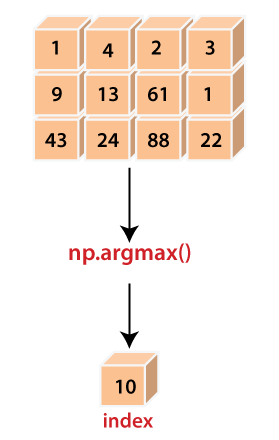📌 相关文章
- Python numpy.argmax()(1)
- Python中的numpy.argmax
- Python中的numpy.argmax(1)
- Python中的 numpy.argmax()
- Python| numpy matrix.argmax()
- Python| numpy matrix.argmax()(1)
- Numpy MaskedArray.argmax()函数| Python(1)
- Numpy MaskedArray.argmax()函数| Python
- numpy recarray.argmax()函数| Python
- numpy recarray.argmax()函数| Python(1)
- 使用 Python numpy.argmax() 从矩阵中查找最大元素 - Python (1)
- 使用 Python numpy.argmax() 从矩阵中查找最大元素 - Python 代码示例
- matlab argmax (1)
- Python|熊猫索引.argmax()(1)
- Python|熊猫索引.argmax()
- Python|熊猫系列.argmax()
- Python|熊猫系列.argmax()(1)
- matlab argmax - 任何代码示例
- 使用 Python numpy.argmax() 沿列查找最大元素 - Python (1)
- Python| Pandas TimedeltaIndex.argmax
- Python| Pandas TimedeltaIndex.argmax(1)
- Python| tensorflow.math.argmax() 方法(1)
- Python| tensorflow.math.argmax() 方法
- 使用 Python numpy.argmax() 沿列查找最大元素 - Python 代码示例
- argmax vs max (1)
- pytorch 张量 argmax - Python (1)
- argmax 用于 2d 数组 (1)
- pytorch 张量 argmax - Python 代码示例
- 无法评估 np.argmax python - Python (1)
📜 Python numpy.argmax()
📅 最后修改于: 2020-10-27 08:13:02 🧑 作者: Mango
Python的numpy.argmax
在许多情况下,如果数组的大小太大,那么从它们中找到最大元素的时间就太多了。为此, Python的numpy模块提供了一个名为numpy.argmax()的函数。该函数返回最大值的索引以及指定的轴。

句法:
numpy.argmax(a, axis=None, out=None)
参量
x:类似数组
此参数定义了我们想要知道其最大值的源数组。
轴:int(可选)
此参数定义沿其存在索引的轴,默认情况下,它位于扁平化数组中。
out:数组(可选)
此参数定义要在其中插入结果的ndarray。这将是相同的类型和形状,适合于存储结果
退货
此参数定义一个ndarray,其中包含数组的索引。形状与x.shape相同,但沿轴的尺寸已删除。
范例1:
Import numpy as np
x = np.arange(20).reshape(4,5) + 7
x
y=np.argmax(a)
y
输出:
array([[ 7, 8, 9, 10, 11],
[12, 13, 14, 15, 16],
[17, 18, 19, 20, 21],
[22, 23, 24, 25, 26]])
19
在上面的代码中
- 我们导入了别名为np的numpy。
- 我们使用np.arange()函数创建了一个数组“ x” ,其形状为四行五列。
- 我们还在数组的每个元素中添加了7。
- 我们已经声明了变量‘y’并分配了np.argmax()函数的返回值。
- 我们已经在函数传递了数组“ x” 。
- 最后,我们尝试print‘y’的值。
在输出中,它显示了数组中最大元素的索引。
范例2:
Import numpy as np
x = np.arange(20).reshape(4,5) + 7
y=np.argmax(x, axis=0)
z=np.argmax(x, axis=1)
y
z
输出:
array([3, 3, 3, 3, 3], dtype=int64)
array([4, 4, 4, 4], dtype=int64)
范例3:
Import numpy as np
x = np.arange(20).reshape(4,5) + 7
indices = np.unravel_index(np.argmax(x, axis=None), x.shape)
indices
x[indices]
输出:
(3, 4)
26
范例4:
import numpy as np
a = np.array([[5,2,1], [3,7,9],[0, 4, 6]])
index_arr = np.argmax(a, axis=-1)
index_arr
# Same as np.max(a, axis=-1, keepdims=True)
result = np.take_along_axis(a, np.expand_dims(index_arr, axis=-1), axis=-1)
result1
# Same as np.max(a, axis=-1)
result = np.take_along_axis(a, np.expand_dims(index_arr, axis=-1), axis=-1).squeeze(axis=-1)
result2
输出:
array([[0],
[2],
[2]])
array([5, 9, 6])
在上面的代码中
- 我们导入了别名为np的numpy。
- 我们使用np.array()函数创建了一个多维数组‘a ‘。
- 我们已经声明了变量‘index_arr’并分配了np.argmax()函数的返回值。
- 我们已经在函数传递了数组‘a’和轴。
- 我们试图print‘index_arr’的值。
- 最后,我们尝试通过两种不同的方法来获取数组的最大值,这与np.argmax()非常相似。
在输出中,它显示了数组中最大元素的索引以及该索引上存在的值。